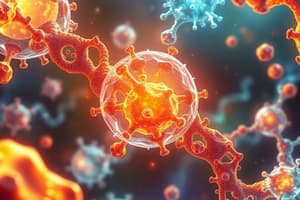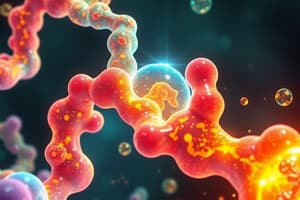Podcast
Questions and Answers
Which of the following best describes the primary function of enzymes?
Which of the following best describes the primary function of enzymes?
- To be consumed during reactions to generate new substances.
- To act as a structural component within cells.
- To maintain a constant equilibrium in biological reactions.
- To accelerate biochemical reactions by lowering activation energy. (correct)
What characteristic of enzymes makes them indispensable for cellular function?
What characteristic of enzymes makes them indispensable for cellular function?
- Their broad specificity, allowing them to catalyze many different reactions.
- Their highly specific, efficient, and regulated nature. (correct)
- Their capacity to alter the equilibrium of reactions.
- Their ability to be produced in large quantities within the cell.
Most enzymes are classified as what type of molecule?
Most enzymes are classified as what type of molecule?
- Nucleic acids
- Carbohydrates
- Proteins (correct)
- Lipids
Which statement accurately describes how enzymes affect chemical reactions?
Which statement accurately describes how enzymes affect chemical reactions?
What does the 'lock and key' hypothesis describe about enzyme function?
What does the 'lock and key' hypothesis describe about enzyme function?
According to the 'induced fit' model, what happens when a substrate binds to an enzyme?
According to the 'induced fit' model, what happens when a substrate binds to an enzyme?
What is the role of the active site in enzyme function?
What is the role of the active site in enzyme function?
In enzyme classification, what type of reaction do oxidoreductases catalyze?
In enzyme classification, what type of reaction do oxidoreductases catalyze?
Which class of enzymes is responsible for catalyzing the joining of two molecules, often coupled with ATP hydrolysis?
Which class of enzymes is responsible for catalyzing the joining of two molecules, often coupled with ATP hydrolysis?
What is a key feature of 'absolute' enzyme specificity?
What is a key feature of 'absolute' enzyme specificity?
Enzymes are highly sensitive to temperature and pH levels. What is the most likely outcome if an enzyme is exposed to extreme conditions outside of its optimal range?
Enzymes are highly sensitive to temperature and pH levels. What is the most likely outcome if an enzyme is exposed to extreme conditions outside of its optimal range?
What is the role of cofactors in enzyme activity?
What is the role of cofactors in enzyme activity?
What is the allosteric regulation of an enzyme?
What is the allosteric regulation of an enzyme?
Which of the following is an example of an enzyme involved in metabolic processes?
Which of the following is an example of an enzyme involved in metabolic processes?
Which is an example of an enzyme that functions in the digestion process?
Which is an example of an enzyme that functions in the digestion process?
Kinases regulate signal transduction pathways by performing what action?
Kinases regulate signal transduction pathways by performing what action?
What is the main function of enzymes in detoxification?
What is the main function of enzymes in detoxification?
Which enzyme plays a role in immune response by breaking down bacterial cell walls?
Which enzyme plays a role in immune response by breaking down bacterial cell walls?
How do enzymes contribute to DNA replication and repair?
How do enzymes contribute to DNA replication and repair?
Which of the following is NOT a general property of enzymes?
Which of the following is NOT a general property of enzymes?
Flashcards
What are Enzymes?
What are Enzymes?
Biological catalysts that accelerate chemical reactions in living organisms.
Key Features of Enzymes
Key Features of Enzymes
Enzymes are highly specific for substrates, accelerate reactions without altering equilibrium, and are regulated by environmental conditions and cellular signals.
How do Enzymes Work?
How do Enzymes Work?
Enzymes work by weakening bonds, which lowers the activation energy required for a reaction.
What is a Substrate?
What is a Substrate?
Signup and view all the flashcards
What is an Active Site?
What is an Active Site?
Signup and view all the flashcards
The Lock and Key Hypothesis
The Lock and Key Hypothesis
Signup and view all the flashcards
The Induced Fit Hypothesis
The Induced Fit Hypothesis
Signup and view all the flashcards
What are Oxidoreductases?
What are Oxidoreductases?
Signup and view all the flashcards
What are Transferases?
What are Transferases?
Signup and view all the flashcards
What are Hydrolases?
What are Hydrolases?
Signup and view all the flashcards
What are Lyases?
What are Lyases?
Signup and view all the flashcards
What are Isomerases?
What are Isomerases?
Signup and view all the flashcards
What are Ligases (Synthetases)?
What are Ligases (Synthetases)?
Signup and view all the flashcards
Catalytic Efficiency
Catalytic Efficiency
Signup and view all the flashcards
Specificity of Enzymes
Specificity of Enzymes
Signup and view all the flashcards
Absolute Specificity
Absolute Specificity
Signup and view all the flashcards
Group Specificity
Group Specificity
Signup and view all the flashcards
Bond Specificity
Bond Specificity
Signup and view all the flashcards
Regulation of Enzyme Activity
Regulation of Enzyme Activity
Signup and view all the flashcards
Temperature and pH Sensitivity
Temperature and pH Sensitivity
Signup and view all the flashcards
Study Notes
- Enzymes are biological catalysts accelerating chemical reactions in living organisms, essential for life-sustaining metabolic processes.
- Enzymes are highly specific, efficient, and regulated, making them indispensable for cellular function.
- Enzymes are typically proteinaceous molecules, with some exceptions like RNA-based ribozymes.
- Enzymes catalyze biochemical reactions by reducing the activation energy required.
- Enzymes are not consumed in reactions, allowing them to be reused multiple times.
- Enzymes exhibit high specificity for substrates.
- Enzymes accelerate reactions without altering the equilibrium.
- Enzyme activity is regulated by environmental conditions and cellular signals.
- Enzymes weaken bonds to lower activation energy, facilitating reactions.
- The substance an enzyme acts on is called the substrate.
- The active site is a restricted region of an enzyme molecule that binds to the substrate.
Lock and Key Hypothesis
- The fit between the substrate and the enzyme's active site is exact, like a key fitting into a lock.
- A temporary enzyme-substrate complex is formed.
- Products released from the active site have a different shape than the substrate.
- The active site is then moulded into a precise conformation.
- The chemical environment is made suitable for the reaction
- Substrate bonds are stretched to facilitate the reaction by lowering the activation energy
- This can explain enzyme specificity and activity loss when enzymes denature.
Induced Fit Hypothesis
- A change in the shape of an enzyme's active site is induced by the substrate binding.
- The change involves alterations in the configuration of the active site.
- This explains how enzymes react with a variety of similar substrates.
Classes of Enzymes
- Enzymes are classified into six major classes based on reaction type.
- This classification follows the International Union of Biochemistry and Molecular Biology (IUBMB) standards.
Oxidoreductases
- Catalyze oxidation-reduction reactions via electron/hydrogen atom transfer
- Examples include:
- Dehydrogenases (e.g., lactate dehydrogenase)
- Oxidases (e.g., cytochrome c oxidase)
Transferases
- Transfer functional groups (e.g., methyl, phosphate) from one molecule to another
- Examples include:
- Kinases (e.g., hexokinase)
- Transaminases (e.g., alanine aminotransferase)
Hydrolases
- Catalyze hydrolysis reactions using water to break bonds
- Examples include:
- Lipases (break down lipids)
- Proteases (break down proteins)
Lyases
- Catalyze the removal or addition of groups to double bonds without hydrolysis or oxidation
- Examples include:
- Decarboxylases (e.g., pyruvate decarboxylase)
- Dehydratases (e.g., fumarase)
Isomerases
- Catalyze the rearrangement of atoms within a molecule (isomerization)
- Examples include:
- Racemases (convert L- to D-isomers)
- Epimerases (e.g., phosphoglucomutase)
Ligases (Synthetases)
- Catalyze the joining of two molecules, often coupled with ATP hydrolysis
- Examples include:
- DNA ligase (joins DNA strands)
- Synthetases (e.g., aminoacyl-tRNA synthetase)
General Properties of Enzymes
Catalytic Efficiency
- Enzymes significantly increase reaction rates by up to 10^17 times faster than uncatalyzed reactions
Specificity
- Enzymes are highly specific for their substrates due to the active site's precise structure.
Types of Specificity
- Absolute: Acts on only one substrate (e.g., urease acts only on urea).
- Group: Acts on a group of related substrates (e.g., hexokinase acts on hexose sugars).
- Bond: Acts on a specific type of bond (e.g., peptidases cleave peptide bonds).
Regulation
- Enzyme activity is tightly regulated by allosteric regulation
- Allosteric regulation involves the binding of effectors at allosteric sites.
- Covalent modification, such as phosphorylation and glycosylation, are ways that enzyme activity is tightly regulated
- Feedback inhibition means reactions are regulated because End products inhibit earlier enzymes in a pathway.
Temperature and pH Sensitivity
- Enzymes have optimal temperature and pH ranges.
- Deviations can lead to denaturation or reduced activity.
Cofactors and Coenzymes
- Many enzymes require non-protein molecules for activity
- Cofactors include inorganic ions (e.g., Mg2+, Zn2+).
- Coenzymes are organic molecules (e.g., NAD+, FAD).
Functions of Enzymes
Metabolism
- Enzymes drive catabolic (breakdown) and anabolic (synthesis) pathways
- Examples include:
- Glycolysis (breakdown of glucose)
- DNA polymerase (DNA synthesis)
Digestion
- Digestive enzymes break down food into absorbable nutrients
- Examples include:
- Amylase (breaks down carbohydrates)
- Pepsin (breaks down proteins)
Cellular Signaling
- Enzymes regulate signal transduction pathways
- Examples include:
- Kinases (phosphorylate proteins)
- Phosphatases (dephosphorylate proteins)
Detoxification
- Enzymes neutralize toxins and drugs
- Examples include:
- Cytochrome P450 (metabolizes drugs in the liver)
- Catalase (breaks down hydrogen peroxide)
Immune Response
- Enzymes play roles in immune defense mechanisms
- Examples include:
- Lysozyme (breaks bacterial cell walls)
- Proteases in antigen processing
DNA Replication and Repair
- Enzymes ensure accurate DNA replication and repair
- Examples include:
- DNA polymerase (synthesizes DNA)
- DNA ligase (repairs DNA breaks)
Studying That Suits You
Use AI to generate personalized quizzes and flashcards to suit your learning preferences.



